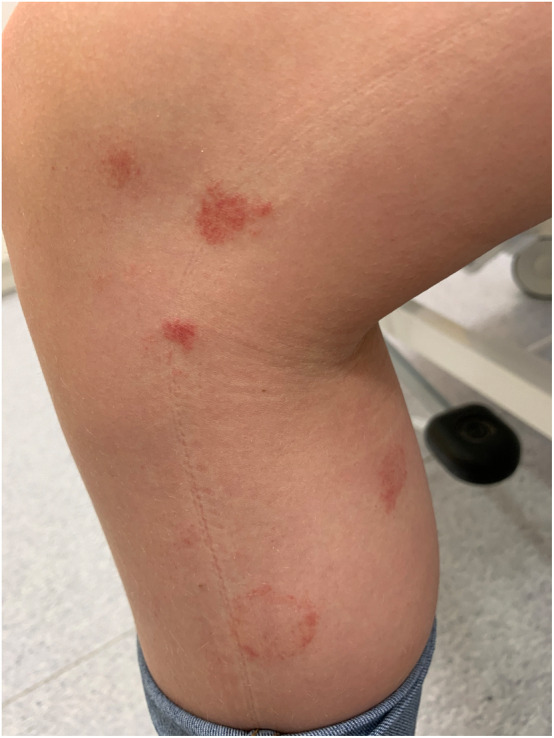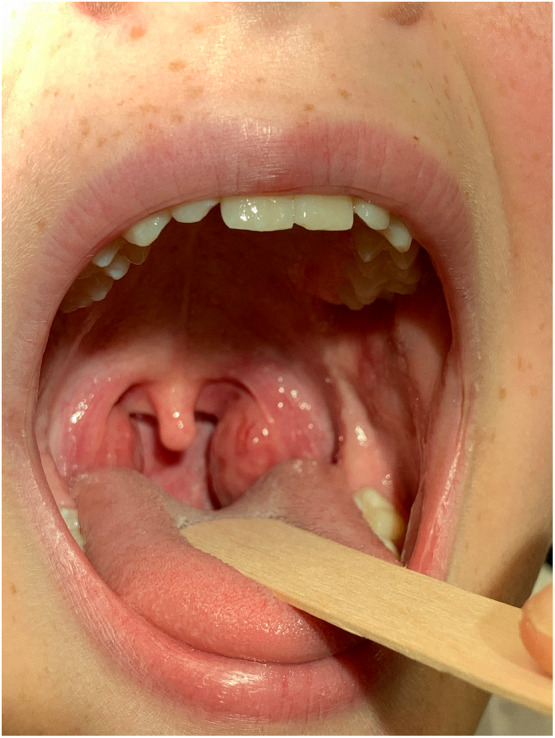Dear Editor,
A new beta‐coronavirus called severe acute respiratory syndrome coronavirus 2 (SARS‐CoV‐2) has been identified as the cause of the pandemic coronavirus disease 19 (COVID‐19). Children appear to be less affected by COVID‐19 than adults by observed case rates in epidemiological studies. The majority of children have a mild disease and good prognosis. Children may also be completely asymptomatic for SARS‐CoV‐2 infection. 1 , 2 Variable cutaneous symptoms have been identified in association with COVID‐19. 3 They might be useful to identify asymptomatic or unrecognized COVID‐19 cases.
A 13‐year‐old girl presented with purpuric lesions on the lower extremities that developed during the last 5 weeks. She was on winter holidays in the Austrian Alps and noted a mild common cold about 1 week before the skin eruptions developed. She had no history of medical drug use.
The macular nonpalpable lesions were asymmetric but well circumscribed and asymptomatic. Healing started from the center of the lesion.
On examination we noted 1‐ to 3.5‐cm‐large purpuric lesions on the legs, sparing the plantar skin (Figure 1 ). She had a mild lymphadenopathy submandibular on the left side. Orally, bilateral massive enlarged tonsils were noted, but no malodor, secretions or aphthous lesions (Figure 2 ).
FIGURE 1.

Purpuric macules on the leg. The distal annular lesion is the oldest one. Regression is seen in its center
FIGURE 2.

Tonsillitis of the palatine tonsils. Clinically no signs of a bacterial infection
The girl was otherwise in good health. No fever, malaise, arthritis or arthralgia, no diarrhea. She did not suffer from anosmia. Routine laboratory was unremarkable, except C‐reactive protein of 6.8 (normal <5 mg/L). Reverse transcriptase polymerase chain reaction for SARS‐CoV‐2 was positive from oropharyngeal swab. Bacteriology from a tonsil swab was unremarkable.
In a recent review on cutaneous manifestations of COVID‐19 disease, the most common findings were maculopapular rash 36.1% (26/72) of patients, followed by papulovesicular rash (34.7%), painful acral red purple papules (15.3%), urticaria (9.7%), livedo reticularis (2.8%), and petechiae (1.4%). 4
In a French study, 14 COVID‐19 patients with vasculocutaneous symptoms were analyzed. The authors found on case of non‐necrotic purpura and one case of necrotic purpura. 5
A Spanish study with 439 COVID‐19 patients mentioned purpura in association with maculopapular rash as an uncommon finding. 6
Acute palatine tonsillitis is an infectious inflammatory process of the tonsillar tissues and occurs commonly in school‐aged children. Viral and bacterial infections can be responsible. 7 In our case, tonsillitis may be due to SARS‐CoV‐2 but coinfections are not uncommon.
Schamberg's purpura or purpura pigmentosa progressive are characterized by asymmetric distribution on the legs. The disease can run a chronic course. Transitory Schamberg's disease is pruritic, but this was not observed in our patient. 8
In conclusion, Schamberg's disease has to be added to the list of nonspecific findings of SARS‐CoV‐2 infection. The observation in a single case is a limitation of this report. If Schamberg's purpura are sign of mild or asymptomatic disease, then this has to be confirmed by further studies.
CONFLICT OF INTEREST
The authors declare no potential conflict of interest.
REFERENCES
- 1. Mehta NS, Mytton OT, Mullins EWS, et al. SARS‐CoV‐2 (COVID‐19): what do we know about children? A systematic review Clin Infect Dis 2020;ciaa556. 10.1093/cid/ciaa556. [Epub ahead of print]. [DOI] [PMC free article] [PubMed] [Google Scholar]
- 2. Zhou MY, Xie XL, Peng YG, et al. From SARS to COVID‐19: what we have learned about children infected with COVID‐19. Int J Infect Dis. 2020. 10.1016/j.ijid.2020.04.090. [Epub ahead of print]. [DOI] [PMC free article] [PubMed] [Google Scholar]
- 3. Wollina U, Karadağ AS, Rowland‐Payne C, Chiriac A, Lotti T. Cutaneous signs in COVID‐19 patients: a review. Dermatol Ther. 2020. 10.1111/dth.13549. [Epub ahead of print]. [DOI] [PMC free article] [PubMed] [Google Scholar]
- 4. Sachdeva M, Gianotti R, Shah M, et al. Cutaneous manifestations of COVID‐19: report of three cases and a review of literature. J Dermatol Sci. 2020. 10.1016/j.jdermsci.2020.04.011. [Epub ahead of print]. [DOI] [PMC free article] [PubMed] [Google Scholar]
- 5. Bouaziz JD, Duong T, Jachiet M, et al. Vascular skin symptoms in COVID‐19: a French observational study. J Eur Acad Dermatol Venereol. 2020. 10.1111/jdv.16544. [Epub ahead of print]. [DOI] [PMC free article] [PubMed] [Google Scholar]
- 6. Galván Casas C, Català A, Carretero Hernández G, et al. Classification of the cutaneous manifestations of COVID‐19: a rapid prospective nationwide consensus study in Spain with 375 cases. Br J Dermatol. 2020. 10.1111/bjd.19163. [Epub ahead of print]. [DOI] [PMC free article] [PubMed] [Google Scholar]
- 7. Sidell D, Shapiro NL. Acute tonsillitis. Infect Disord Drug Targets. 2012;12(4):271‐276. [DOI] [PubMed] [Google Scholar]
- 8. Antonov D, Kamarashev J, Kazandjieva J, Neykova T, Tsankov N. The rash that becomes purpuric, petechial, hemorrhagic, or ecchymotic. Clin Dermatol. 2020;38(1):3‐18. [DOI] [PubMed] [Google Scholar]


